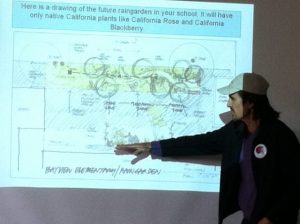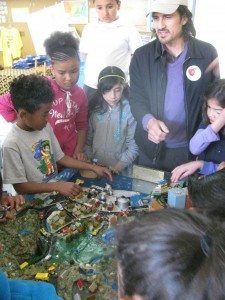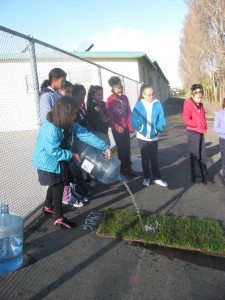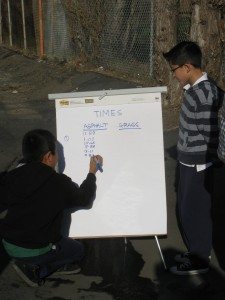A bird-friendly bioswale in Richmond (someday)
By Ilana DeBare
Fifteen wiggly fourth graders crowded into a narrow asphalt strip between their North Richmond schoolyard and the fence bordering Rheem Creek. “You are standing in what may be your future rain garden!” declared landscape architect Bob Birkeland, a volunteer with Golden Gate Bird Alliance’s Eco-Education program.
That didn’t seem to mean much to the kids, who were happy just to be outside on a beautiful spring morning. But then Bob had them look down at the barred storm drain under their feet.
“If I spill soda in here, where’s it going to go?” he asked.
“The creek! The bay! The hummingbirds! The fish!” the kids chorused, remembering their Eco-Ed field trip to the Point Pinole shoreline.
“Right, and do fish like soda?”
“Nooo!”

Bob and his colleague Rich Walkling from Restoration Design Group joined GGBA Eco-Education Director Anthony DeCicco last month to give a hands-on lesson on watersheds, pollution and the future rain garden planned for Bay View Elementary School in Richmond.
A rain garden or bioswale is a planted depression that allows rainwater runoff from paved areas to be absorbed into the soil.
Through its Eco-Education program, Golden Gate Bird Alliance is partnering with Bay View Elementary to design and build a rain garden in an unused section of the asphalt schoolyard. The garden will play a double role — serving as an outdoor environmental study area, and eliminating some of the pollution that flows into the creek and then on into Breuner Marsh, an Important Bird Area along the bay.

Last month’s rain garden lesson came midway through the year’s Eco-Education curriculum. “Mister Anthony” had already met with the children several other times, including the Pt. Pinole field trip.
Now he began by by displaying a map of North Richmond, from the hills to the bay. “What’s the name of the creek next to your school?” he asked the classroom of about 30 kids, the first of three classes he’d meet with that day. “Creeks and rivers — do they start in the bay or finish in the bay? I guarantee you will know by the end of the day.”
Switching back and forth smoothly between English and Spanish, Anthony showed slides of local wildlife like birds and dragonflies that rely on Rheem Creek.
Then he split the class in half. Fifteen stayed inside to gather, fascinated, around a huge 3-D model of an East Bay community, complete with hills, bay, tiny houses, roads, and storm drains. Using colored cake icing to represent pollutants such as motor oil, the kids dripped “rain” onto the model and saw how debris gets washed down hillsides and into the bay.

Meanwhile, the other half headed out to the yard with Bob, Rich and Bay View fourth-grade teacher Karen Stout. As they gathered at the storm drain, Rich and Bob explained that the surrounding asphalt would be removed and replaced with dirt for the rain garden. They held up some small seedlings with long roots that they’d brought.
“We want all the water to come in here, stay for a while, and go down into the roots, where bugs will be munching away at all the nasty stuff that comes off the streets,” Rich said.
Then he led the kids in an experiment about the absorptive and remediating qualities of asphalt-versus-soil. (Without any of those big intimidating words.)
Some kids were given jugs of water to pour on rectangles of turf that Rich and Bob had brought. Others had jugs to pour on similarly-sized sections of asphalt. Which water would reach the finish line (and thus the creek and bay) most quickly?
One, two, three…. pour!


The indoor and outdoor groups switched places. And then everyone returned to the classroom for a discussion of what they’d seen and learned. “How will the new rain garden attract animals to the school?” Anthony asked the group. “How will the rain garden protect Rheem Creek and the bay?”
The kids’ shoes were a bit wetter than when they started. Mrs. Stout’s classroom floor was a lot wetter.
Actual construction of the 300-linear-foot rain garden remains in the future, maybe in the 2013-14 school year, depending on permit approvals and funding.
![Bayview_SK-1 RainGarden[5]](https://goldengatebirdalliance.org/wp-content/uploads/Bayview_SK-1-RainGarden5-300x194.jpg)
And ninety families that are a lot less likely to let their old paint, motor oil or other pollutants flow into streets, storm drains and wildlife habitat along the bay.
————————————-
Golden Gate Bird Alliance’s Eco-Education program serves 700 elementary school children and their families in low-income communities in East Oakland, Richmond and San Francisco, including three classes of fourth graders at Bay View Elementary School. Contributors to the Bay View rain garden project so far include The Watershed Project/Contra Costa County, the Giles W. and Elise G. Mead Foundation, and Restoration Design Group. Our Eco-Education program welcomes volunteers: for information, please see our web site.
